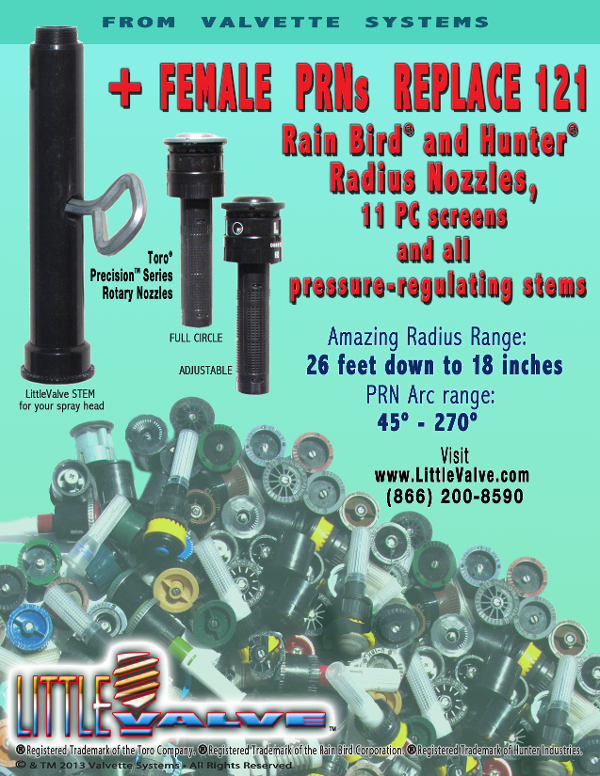REAL WATER CONSERVATION
From the Many Benefits of In-stem Flow Regulation
Water Saving Sprinklers and Sprinkler Parts Featuring LittleValves
the World’s Most Efficient Sprinkler Systems

With LittleValve In-stem Flow Regulating (IFR) Parts,
every sprinkler and nozzle you buy:
- Saves Water
- Saves Time
- Saves Labor
- and Works Better
Nationwide, you’ll find the many benefits of In-stem Flow Regulation within the water-conservation sprinkler heads and parts you need when you look to Valvette Systems. Our proprietary IFR sprinkler parts and Little Tuffy pop-up sprinklers were specifically designed and engineered to save water, time, and labor. This was done by two irrigation professionals from the Los Angeles area in Southern California, with a combined 95 years of experience.
LittleValve IFR Benefits
With total control over each sprinkler head due to In-stem Flow Regulation, pinpoint the precise area you want watered.
Eliminate overspray entirely even if the system pressure exceeds 175 p.s.i.
- Say goodbye to 5′, 8′, 10′ and 12′ nozzles. LittleValves can bring the spray from a 15 foot radius nozzle down to 6 feet without distortion and without closing down. The larger orifice of 15′ nozzles has less chance of getting clogged and is easier to clean.
- Furthermore, with 15′ nozzles you get BFH: Bigger, Fatter and Heavier droplets that resist wind drift better, penetrate the soil deeper, and diffuse throughout the soil wider.
- Every LittleValve part is pressure-regulating or pressure-compensating, therefore, using 15′ nozzles at radius distances of 14′ or less, misting/fogging is eliminated entirely regardless of how high the pressure is; over 14′, misting is substantially reduced. You’ll never need pressure-compensating screens and devices nor pressure-regulating stems.
- Independent testing confirms 30% to 80% higher uniform water application with adjusted-down 15′ nozzles compared to smaller radius nozzles. The higher uniformity means you save from 7% to 47% of the water normally used to irrigate a given area just on higher uniformity alone. (See the Actual Water Savings table on the Test Data page of this site.) Higher uniformity and deeper penetration of water droplets means a better-looking garden.
- In 2008 and into 2009, water saving trials had been conducted primarily in the cities of Agoura Hills, Los Angeles (Canoga Park area), and Anaheim–all in Southern California–along with Ft. Lauderdale, Florida. With the combination of higher uniformity, elimination of overspray and elimination of misting and fogging, the trials yielded typical savings from as low as 18.5% up to as high as 83%. The average savings is from 30% to 50%.
- Pop-up risers stay in the extended “UP” position and do not retract even when the nozzle is removed so there’s no need for special tools nor a helper to hold up the riser while flushing the lines. Since the riser stays up, dirty water can’t flow back into the sprinkler lines.
- Service individual spray heads and above-grade sprinklers without shutting down the whole system. Save time and water not going back and forth to the controller. Save when heading up new jobs or servicing existing ones even if you have remote control. Testing at the Center for irrigation Technology (C.I.T.) shows water savings in excess of 80% when nozzling up new installations.
- No more getting blasted with water while removing nozzles when the system is running just to save trips to the controller. Saves hours of labor, which means dollars in your pocket.
- Eliminate erosion while flushing lines, risers and heads during the installation or servicing of sprinklers on hillside slopes.
- Now you can have drip systems without 1/4″ tubing. Eliminate special filters, emitters, pressure regulators and, in most cases, special valves. With LittleValve parts, you can mix drips, micro-sprays and regular sprays on the same valve system. (See what nozzles to use in the “Drip & Micro-Spray Information” tab.)
- Fittings and stationary shrub bodies (shrub adapters) are slotted. Use just one pair of channel locks and a $5.50 open-end wrench when working on them instead of two $15.00 pairs of channel locks.
- Complete flow control even if the filter screen is missing. No distorted spray when limiting flow and no vibrating adjustment screws that shut themselves off. NEVER AGAIN TOUCH THAT LITTLE SCREW ON TOP OF THE NOZZLE.
- LittleValve products provide you with the finest irrigation systems possible. No other company offers this 21st century technology featuring maintenance and water friendly sprinkler parts and fittings.
- It’s like having a little gate valve under every sprinkler head you ever had to work on, thereby eliminating irrigation aggravation by making your sprinkler systems maintenance friendly.
- Contractors: A great way to make money by upgrading the existing systems of your customers. In the long run, this saves them water and future maintenance costs and, as a result, makes your own jobs easier. Everybody Wins!
- If a nozzle gets lost, cut off or broken, the rest of the system still operates at approximately 90% of its efficiency.
- Ends reliance on slow-operating and sometimes non-operating remote control apparatus.
- Easy to retrieve the pop-up riser stem when it snaps back into the housing.
- Keep all the water you flush inside the planter – direct the flow wherever you want.
- Dirty water can’t flow back into the open riser stem.
- Works on most male and female plastic pop-up heads.
- 1/4″ Allen wrench included to regulate the amount of water you flush or shut it off altogether.
- Contains its own screwdriver for prying up the head – plus adjusting nozzle when you’re ready to finish up.
- Has 3/4″ male threads to connect up for back flushing, remote flushing or for a temporary sprinkler head. Plus, you can connect up a pressure gauge for reading the pressure at any head on the system.
Simple & Easy Sprinkler Head Maintenance –
an important Benefit of In-stem Flow Regulation
Eliminate trips back and forth to valve and controller
just to service a clogged sprinkler or change-out a nozzle
Originally developed to make sprinkler maintenance easier and faster. Pictured below is a pop-up sprinkler being flushed by just one person while the valve is fully open without helpers and without going back and forth to the controller or valve.
During the process you see in the photo below, the pop-up stem will never retract until you shut off water to the system.
After flushing, shut off flow exiting the extended pop-up stem by turning the little key clockwise. Insert filter, re-attach the nozzle. Then turn key counter-clockwise until water exits nozzle at the precise distance you want. Pull out the key and you’re done.
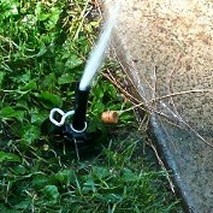
You have full On/Off control at every sprinkler regardless of what LittleValve IFR part you have in your landscape – pop-ups or above-grade shrub adapters.
CAUTION: You WILL get spoiled using LittleValve parts.
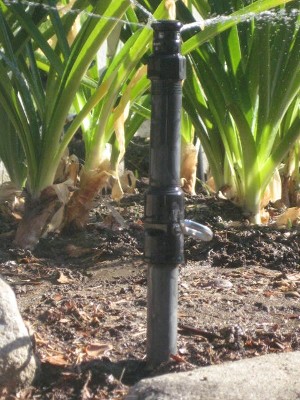
Side and Corner Strip Nozzles that can be mixed with PRNs on the same Valve Systems
When combined with LittleValve parts or sprinklers, Precision Rotating Nozzles (PRNs) will – in almost all cases – likely be the only radius nozzle you will ever need if the distance range is anywhere between 14 -18 inches [regardless of pressure] up to 20 – 25 feet [depending on pressure]. However, PRNs, being a radius nozzle, do not replace side strips, center strips or corner strip nozzles.
There will be many times in which you as the irrigation specifier, contractor, consultant or even a homeowner, will encounter situations where you will need to incorporate side strip nozzles into the same valve system as your PRN radius nozzles or any other radius-type rotating nozzles. Parkways are an excellent example of where you usually need side strips.
The idea is to always keep flow rates of the different sprinklers on any given valve system as close as possible. The following recommendations are made with that goal in mind.
1. Precision Spray Nozzle – Side strips
If the left/right side distance the side strip needs to cover is 9 – 10 feet or more on each side, use Toro’s Precision Spray Nozzle (PSN) 4 X 30 side strip or 4 X 15 LCS/RCS corner strips. The flow rate of this nozzle when opened at 7 – 10 feet or more on each side is similar to the flow rate of most all rotating nozzles. This nozzle typically does not do a good job of watering when taken down less than 7 or 8 feet – left and/or right – even with LittleValves. The PSNs do come in both male and female styles. There is also a 4 X 18 foot model, which allows a little more flexibility for the lower distances.
PSNs are on the rebate list of the Southern California Metropolitan Water District (MWD).
2. Hunter Nozzle – Side strips
When the left/right side distance the nozzle needs to cover is under 5 – 6 feet on each side, use Hunter’s SS530 – a 5 X 30 side strip or LCS/RCS 515 corner strips. The flow rate of this nozzle when opened at 6 ft. or less on each side becomes more similar to the flow rate of the PRN. With LittleValves, you can dial this left/right distance all the way down to 2 – 3 feet left and right and water will always exit out in front of the nozzle, which other side strips just cannot do. Hunter’s side and corner strip nozzle line comes only in female styles.
Unfortunately, Hunter’s side strip nozzles are not on the rebate list of the Southern California Metropolitan Water District (MWD).
After years of working with LittleValve products, we came up with the above recommendations. We have proven to ourselves over and over that these combinations work best and even though there might not be matched precipitation between all the nozzles, the end result is significant water savings with a great-looking landscape with little or no over-spraying, little or no water lost to misting/ fogging when high pressure exists, and rarely are there pockets of excess water usage ever being detected.
LittleValve Sprinkler Parts Include Pop-up Riser Replacement Stems with In-stem Flow Regulators for most sprinkler manufacturers as well as stationary above-grade parts.
Pinpoint the precise area you want watered, eliminate overspray, and say goodbye to 5, 8, 10, and 12-foot nozzles.
LittleValves bring the spray from a 15′ radius down to six feet without distortion and without closing down. 15-foot
nozzles clog up less, eliminate wasteful misting/fogging, are much easier to clean, plus they resist wind-drift better and the
droplets penetrate into the soil deeper, reducing watering time significantly.
And you never touch the little screw atop the nozzle again.
Further, there’s no need for special tools to hold the riser up while flushing the lines or switching nozzles. Upon turning on
the water, LittleValve pop-up risers remain in the ‘UP’ position to prevent dirty water from getting into the lines, as well as for easier servicing and do not retract until the system is shut off.
The 3 pictures below are from Trial No. 4 of the Metropolitan Water District testing. See Test Data tab.
Look at the difference with this first pair of pictures showing a single zone
in a 12-foot wide median strip with brand new 12′ MPR Rain Bird nozzles WITHOUT LittleValves.
Notice in these pictures the loss of water via misting/fogging due to high pressure
coupled with smaller nozzles – along with over spraying into the street.
This zone has 41 sprinklers in it.
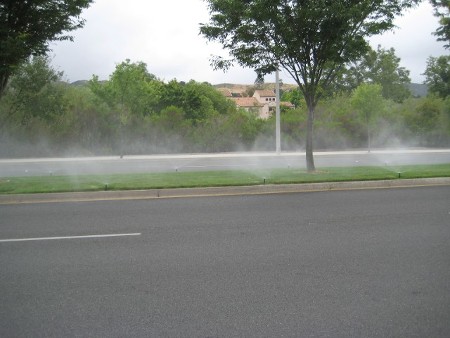
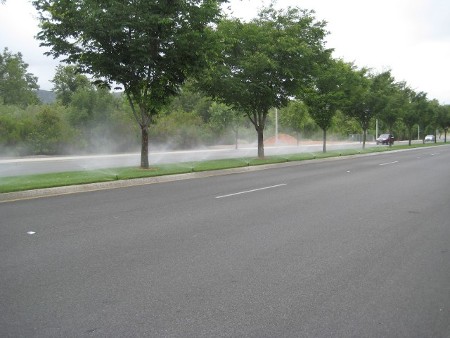
Now look at this picture to the right of an adjacent zone in the same 12′ wide median strip, also with 41 sprinklers but with new 15′ Rain Bird nozzles and LittleValve parts, (in this case, Little Tuffy pop-ups.) Notice the obvious lack of water-wasting misting/fogging and literally no over spraying onto the street.
These three pictures are of a 12′-wide grass median strip on Lost Hills Road in the City of Calabasas, California. The picture to the right shows sprinklers with In-stem Flow Regulators (LittleValves) with 15′ nozzles. There is not matched precipitation. The 2 upper pictures are an adjacent valve section of the median strip with the same amount of sprinklers (41). These sprinklers are regular 6″ pop-ups with 12′ MPR nozzles – hence with matched precipitation.
As can be seen in Trial No. 4 of the Metropolitan Water District (MWD) testing, the first test in the Test Data tab, the non-matched precipitation sprinklers with LittleValve IFRs saved 33.5% more water than the matched precipitation sprinklers. See pages 3 and 12 of the MWD testing for the relevant data.
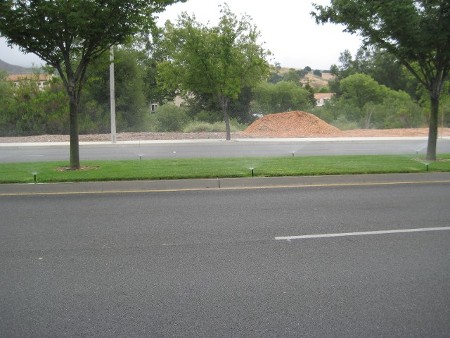
The Hows & Whys of LittleValve Water Savings

The World’s Most Efficient Sprinkler Systems
A. OVERSPRAY
Because you dial in the distance you want the water to travel when exiting the nozzle, you are able to eliminate overspray. Everybody who works with sprinklers has encountered the problem of the little nozzle screw atop the nozzle, which oftentimes shuts down after adjustment. At the most, the little screw atop the nozzle can only be turned down 25% of its value. This is why they make nozzles in 5’, 8’, 10’ 12’ and 15’ radiuses. Conversely, the LittleValve screw is located below the nozzle, its setting never changes, hence, one only needs 15’ nozzles, which can then be adjusted from 15 feet down to 5 or 6 feet. The end result is that you can substantially or completely eliminate water spraying onto adjacent streets, sidewalks, buildings and cars.
B. MISTING & FOGGING
Misting and fogging of spray sprinklers is a major source of water waste. The primary reason for misting and fogging is high pressure, which is exacerbated when using smaller radius nozzles. One of the major benefits of In-stem Flow Regulation is that EVERY LittleValve sprinkler part is pressure-regulating.
- LittleValves eliminate all forms of pressure regulation, i.e. expensive Pressure Regulating Stems (PRS), pressure-compensating screens (PC Screens) and pressure regulators.
- The orifice of a 15’ nozzle is 1/8” in diameter, hence their larger orifices clog up less than smaller orifices.
- The larger orifices of 15’ nozzles clog up less than smaller orifices.
- Droplets from 15′ nozzles are BFH – Bigger, Fatter and Heavier, resisting wind drift far better than droplets from smaller radius nozzles.
- The larger droplets also penetrate the ground much deeper and diffuse in the soil better.
Regardless of pressure, 15’ nozzles in concert with LittleValves, significantly reduce misting and fogging at distances over 14 feet. They completely eliminate it at distances less than 14 feet.
NOTE: Any consideration of optimum nozzle pressure does not apply to LittleValve sprinklers or parts. There is no optimum pressure range for nozzles outfitted with In-stem Flow Regulators.
C. UNIFORMITY
IFRs greatly increase the uniformity of the water being applied. The higher the uniformity rate, the less water needed to meet ET (Evapo-Transpiration rate.) Higher uniformity obtained from using LittleValves is achieved in two different ways:
- LittleValves allow for precise placement of water. Higher uniformity is achieved by putting all the water in the form of larger droplets exactly where they are wanted.
- The presence of the LittleValve creates a chamber between it and the nozzle. This causes the water to enter the nozzle with less turbulence hence the nozzle works more efficiently.
D. INSTALLING & MAINTAINING SPRINKLERS
One of the biggest benefits of In-stem Flow regulation is the On/Off control it provides at the sprinkler you’re working on without affecting the other sprinklers in the same valve system.
Little Tuffys and LittleValve pop-up stems are shipped in the ‘Closed’ position, so after installation, very little water exits the nozzle. Remember: IFRs remain in the ‘UP’ position with or without a nozzle attached. They do not retract until the sprinkler water valve is shut off. Therefore, one person can flush and nozzle up each sprinkler and then close the LittleValve before moving onto the next. Hence, very little water is used when nozzling-up and the site is kept dry and not muddied as a bonus. Final adjustments can now wait until after all the plants and lawns are planted.
NOTE: When nozzling up a valve system, it’s best to open a few of the IFRs a little to relieve pressure. This helps to avoid blowing out weak water lines and connections in the system. This is important when working on systems with static pressure in excess of 70 p.s.i.
Maintenance of existing sprinklers with LittleValves is performed by just one person without going back and forth to the valve or controller. Reduces reliance on slow-acting remote control apparatus. When flushing sprinklers with LittleValves, one flushes cups of water instead of the gallons normally used.
In March of 2003, a report was issued by the Center for Irrigation Technology (C.I.T.) describing how much labor and water was saved during installation and maintenance procedures. Water savings during installation were as high as 82% and during maintenance procedures as high as 36%. As a bonus, average savings on labor during maintenance operations was logged at 66%. (See the C.I.T. testing in the Test Data & Water Savings Report tab of the Tips & Technical Info page.)
IFRs – The World’s Only Water Saving Sprinklers and Sprinkler Parts!!
COMPARING THE COST EFFECTIVENESS OF IN-STEM FLOW REGULATORS (IFR) vs. OTHER WATER CONSERVATION METHODS
The following graph was prepared by the Water Use Efficiency division of the Orange County Municipal Water District (OCMWD). It was used for the District’s Water Use Efficiency Master Plan. It compares 30 water conservation technologies, methods and products in use throughout the Metropolitan Water District’s Southern California region. (Likely throughout the entire western United States.) Note at the top of the chart, the LittleValve In-Stem Flow Regulator is shown to be the most cost-effective way to save water. An interesting side note is that no. 4 out of 30 costs over double the $ 91.00 it costs IFRs to save an acre foot of water – 325,829 gallons.
Not only do LittleValves save water, they are the most economical way to save that water. Another huge benefit of In-stem Flow Regulation.
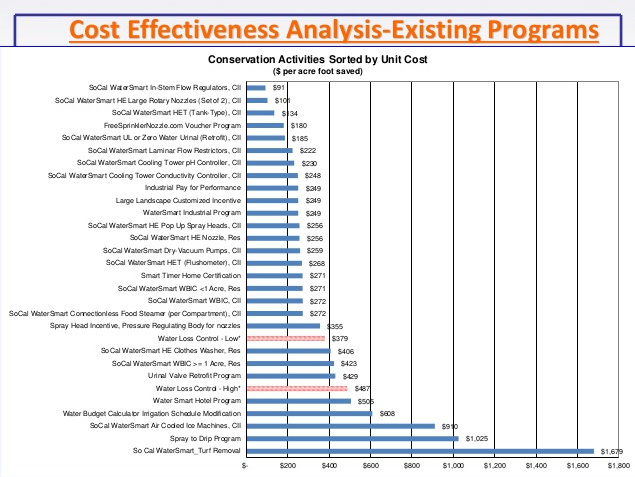
Comparisons vs. The Competition
PRN/Little Valve Combo
Distance Range: 20 – 25 feet down to 18 inches
Arc range: 45° – 270°
The ultimate in high-efficiency irrigation. No other sprinkler is comparable.
Look below to see the number of female radius nozzles you DON’T need when you have a LittleValve part and 2 female PRNs –
just one adjustable model and a full circle model.
ROTARY NOZZLE DISTANCE/ARC COMPARISON GUIDE
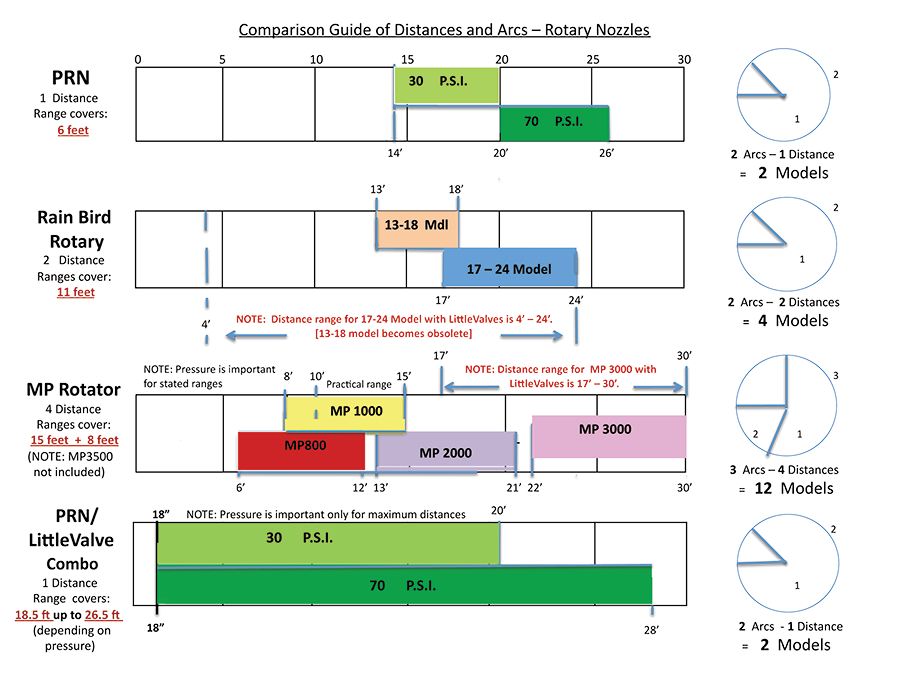
ONE LittleValve part and 2 Female PRNs
eliminate 121 Rain Bird and Hunter radius nozzles
[along with all Pressure-Regulating stems and pressure-compensating screens]
